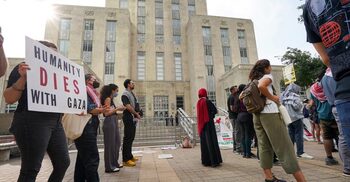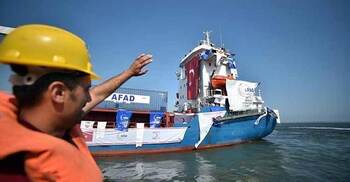More than 100,000 flee Rafah as Israel steps up strikes, says UN

More than 100,000 people have fled Rafah after Israel intensified its bombardment, UN officials have said, in the largest movement of population in Gaza for many months.
Humanitarian officials are tracking the number of people fleeing Rafah, the southernmost city in Gaza, where more than 1 million people displaced from elsewhere in the territory have been sheltering.
The numbers are expected to rise, with deep concern among aid officials on Thursday that the newly displaced people will end up in makeshift encampments without any services, living in the rubble of their former homes without “basic essentials necessary for life”.
One UN official in Rafah said: “There is a lot of fear and trepidation. The roads are very congested with cars, donkey carts, trolleys, pick-up trucks and people walking. Some have already been displaced multiple times and are trying to take material for shelter with them, which isn’t easy; others are moving for the first time.
“We could be talking about 300,000 within a few days. The problem is there is basically nowhere where that kind of number of people can go which is safe and equipped to provide basic essentials necessary for life.”
With no aid stockpiles after seven months of war, and supplies into southern parts of Gaza cut off after Israel’s seizure of the Palestinian side of the Rafah border crossing on Tuesday, there was “not a lot” agencies could do to help, a second official said.
There were reports of at least 20 airstrikes and 12 incidents of tank shelling on Thursday, with seven rocket launches by Hamas at Israel or Israeli troops.
The Israeli strikes were mainly concentrated on eastern neighbourhoods which have been evacuated after instructions to do so were issued on Monday by the Israel Defense Forces (IDF). Further strikes and heavy shelling were reported throughout Rafah with targets elsewhere having been hit, causing casualties and widespread fear.
The attacks come amid a new round of ceasefire talks in Cairo and despite explicit opposition from the US. They have prompted a fresh crisis in relations between Israel and its staunchest ally, with the US president, Joe Biden, saying he will cut off the supply of US munitions used by Israel to attack urban environments such as Rafah.
Biden’s decision prompted fury in Israel. On Thursday, Israel’s foreign minister, Israel Katz, said the country would “continue to fight Hamas until its destruction”, adding “there is no war more just than this”.
Bezalel Smotrich, the far-right finance minister, called for Rafah to be “conquered completely and the sooner the better”.
Officials at the Emirati hospital, one of the few remaining functioning medical facilities in the city, were preparing to scale down operations for fear of an Israeli attack. This will reduce even further already inadequate provision for the wider Rafah population.
The Abu Yousef al-Najjar hospital in Rafah’s east was evacuated on Tuesday. The UN is planning to try to retrieve medicine and equipment with a “high risk” convoy on Thursday, medical officials said.
Other medical facilities in Rafah have been overwhelmed in recent days, with the director of the Kuwaiti hospital issuing a desperate call on social media in the small hours of Thursday for medical professionals to help treat casualties.
The health ministry in Gaza on Thursday reported at least 60 more deaths over the previous 24 hours. Since Monday when Israel ordered residents of eastern Rafah be evacuated, the daily reported toll has been above 50, up from a peak of 33 earlier in May.
Residents described being terrified by drones flying through streets, hovering over potential targets before moving on, and the constant sound of large blasts.
“I cannot walk, my legs won’t hold me up any longer. I have been scared for so long,” said one 45-year-old man, who has not been able to leave because he lives with his sick and elderly parents.
Aid officials say they are increasingly concerned by an acute shortage of fuel and food. “None is coming in, and unless some does, we will be unable to move or run the generators which power the water pumps and our communication systems,” said one UN official.
A second UN official estimated remaining supplies were enough for “48 hours” of normal operation.
Though the IDF described the attack on the Rafah crossing as a limited military operation, not the long-threatened full-scale assault on the city, senior Israeli officials said the offensive would continue until Hamas was “eliminated from Gaza”.
Israel’s government and military say remaining Hamas forces are based in Rafah and that top leaders are sheltering in tunnels there, using hostages held throughout the seven month-long war as human shields.
Ali Barhoum, a medic who was evacuated from the al-Najjar hospital on Tuesday, said: “Now the [Israeli] army is stationed and bombing east of the city in the al-Shouka neighbourhood, as well as east of the Rafah crossing, but there are some targeting and bombing in some areas in the south and west of Rafah too.
“Yesterday we did not receive any dead because they were all transferred to Kuwait Specialized hospital because there are no mortuaries for the dead or even a morgue [anywhere else]. The death toll last night was about eight.”
Witnesses on Thursday morning reported one strike on a house in al-Shouka belonging to a doctor in which numerous civilians were killed.
According to internal UN memos, 22,000 people had left Rafah by Wednesday evening, heading to the coast, mainly families “who moved in vehicles, trucks, motorbikes and donkey carts with their belongings including flour and food”.
Another almost 50,000 people were heading for Khan Younis, a city devastated by fighting earlier in the war. Many are using the last of their savings to pay transportation fees ranging from $200 (£160) to $400.
The IDF has designated Khan Younis and the coastal zone of al-Mawasi as a “expanded humanitarian zone” where those complying with its instructions to evacuate parts of Rafah will find shelter, food and other necessities.
But aid officials and those already in these locations describe appalling overcrowding, inadequate food, limited and contaminated water supplies, and almost no sanitation. Heavy fighting has left unexploded ordnance in much of Khan Younis.
Dr James Smith, a British specialist in Rafah who has visited both locations, said: “Al-Mawasi is very congested. People are pitching up trying to find some space, but there isn’t anywhere. Parts of Khan Younis are just rubble. There is no functional system to sustain life there.”
Israeli authorities have denied restricting aid reaching Gaza, and said the Kerem Shalom border crossing just east of Rafah, the territory’s main cargo entry point, is open despite repeatedly being targeted by Hamas rocket strikes.
An Israeli government spokesperson on Wednesday described aid “piling up” on the Palestinian side of the Kerem Shalom crossing and called on the UN to do better to ensure its distribution. Aid officials in Gaza said they could not reach Kerem Shalom because their staff had fled or been evacuated, and firing was continuing in the immediate vicinity of the crossing.
One UN official said: “We need security clearance, we need people and fuel. We don’t have either … so we can’t get to the [aid].”
The war in Gaza began with Hamas’s 7 October attack on Israel, which resulted in the deaths of about 1,200 people, mostly civilians. During the attack, Hamas seized Israeli and foreign hostages, of whom Israel estimates 128 remain in Gaza, including 36 who the military says are dead. The deaths of two were confirmed by the Israeli military, the Haaretz newspaper reported on Thursday.
Israel, in response to the attack, vowed to crush Hamas and free the captives. It began a military offensive that has killed at least 34,904 people in Gaza, mostly women and children, according to the Hamas-run territory’s health ministry.
Source: The Guardian







